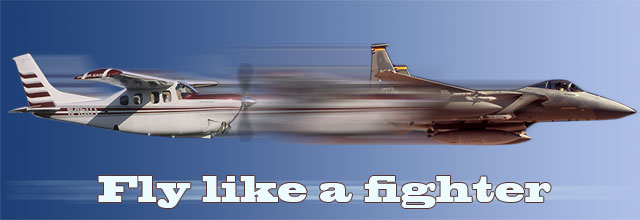Fly like a fighter: Rudders and trim
Who knew being 'lazy' could be so precise?

All military pilots learn how to fly close formation at some point in their training. In fighters, this position is generally defined as three feet of lateral spacing between wingtips with the wingman flying slightly aft of line abreast. To really teach and hone our skills, the pilot training syllabus in the T-38 didn’t just call for close formation going to and from the military operations area. We did acrobatics in close formation with two, three, and four jets.
 The training standard for this wing work is to be able to fly as both lead and wing through a series of Lazy 8 maneuvers with up to 90 degrees of bank, plus and minus 30 degrees of pitch, pulling up to 3 Gs, and with airspeed ranging from 250 to 400 knots. The lead would set power and not touch it during the exercise, but the large changes in airspeed and stick pressure normally caused some bobbling, especially during the early stages of training. Not only was this a good hand-eye coordination workout with the stick and throttles, but it was also an excellent way to directly understand some principles of aerodynamics in action.
The training standard for this wing work is to be able to fly as both lead and wing through a series of Lazy 8 maneuvers with up to 90 degrees of bank, plus and minus 30 degrees of pitch, pulling up to 3 Gs, and with airspeed ranging from 250 to 400 knots. The lead would set power and not touch it during the exercise, but the large changes in airspeed and stick pressure normally caused some bobbling, especially during the early stages of training. Not only was this a good hand-eye coordination workout with the stick and throttles, but it was also an excellent way to directly understand some principles of aerodynamics in action.
I learned a great way to lead the exercise after flying on the wing of another instructor. I was really confused at first because both of his arms were resting on the canopy rails as he flew. His airplane climbed and dived, rolled and pulled as if by magic. Here is what he did.
To start the exercise, he would fly to a specific altitude near the top of the MOA at slow speed—then trim the controls to neutral. Rolling to 90 degrees of bank, the nose would naturally fall because the lift vector was pointing in the horizontal. As the jet accelerated, because it was trimmed for a slow speed, it would pull the nose through a spiral. Now with Gs on the airplane (think angle of attack), a touch of rudder caused the jet to roll. At wings level, 30 degrees nose low, and 400 knots, it just worked out that with the trim set as it was, the jet would fly a 3G pull. Approaching 30 degrees nose high as the airspeed slowed, rudder would again cause the jet to roll. In this fashion, rudder would do all the rolling and the jet would smoothly transition from 1 to 3 Gs throughout the entire maneuver simply due to the trim and airspeed changes. Later, when I briefed my wingmen to also set the trim at the start of the exercise when I set mine, the smoothness and locked position of the jets was worthy of a Thunderbirds performance.
Trim is your friend for more than just straight-and-level flight. While rudder rolls are not as effective in our straight winged general aviation airplanes as they are in swept wing fighters, the rudder still needs to be a natural extension of your feet. The rudder is also more effective in rolling the airplane at higher angles of attack, so always be mindful of what your feet are doing at slow speed (like in the traffic pattern). For a moderate to extreme nose-high recovery, don’t push over, especially in the weather. Increase bank and the nose will naturally fall. For a nose-low recovery, get to wings level to maximize your lift vector to pull you straight up.
A little knowledge of practical aerodynamics goes a long way to making us better pilots.



